
By admin / June 16, 2020
How to Develop Uber for Trucking
How does Uber for trucks app work?
An on-demand truck sharing app works as a digital broker. It matches shippers, who need to deliver cargo, with carriers who drive to the same destination.
Such a platform consists of two separate mobile applications (app for shippers and app for drivers). It also includes a web portal for the admin to manage both types of users. Let’s see how it works in more detail.
- The shipper creates order via a Shipper app. Here, one adds information about the type of cargo, its size, and height, pick up and drop off location, and the delivery date.
- The driver sees a list of orders in the Driver app. Depending on their location and load, one accepts or rejects the order placed. After the order is accepted and picked up by the driver, the platform charges the delivery fee to the shipper. The driver receives money only after the cargo is delivered.
- The platform calculates the delivery price depending on the cargo size, weight, and distance of delivery.
How to monetize a logistics delivery app
There are several ways you can monetize your Uber for trucking apps.
If you have your own fleet, you receive money directly from shippers. At the end of the month, you give your drivers a bonus earned through on-demand delivery.
If you don’t, you can offer premium app features for both types of users. They could include real-time vehicle tracking, packaging, insurance, ERP integration, and so on. You can also charge 10-20% service fees calculated from each order placed via a platform.
Prominent players of the on-demand trucking industry
Trucking is a huge business. In the U.S. only, it generated $260 billion in revenue, 20% of a global total of $1.2 trillion, according to McKinsey & Co. Trucks deliver two-thirds of all products shipped each year. Inefficiency attracts technology. So, entrepreneurs and investors have stepped into the market with technology-driven solutions.
To be successful in an on-demand trucking business, you need to be aware of your competitors. And, to be ahead of them, you need to give more value to your customers. Here are the leading players of the U.S. on-demand delivery market and services they provide.
Uber Freight
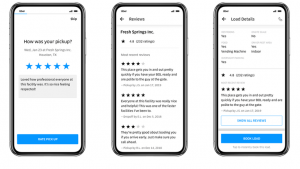
Uber Freight was launched in 2017. Since then, Uber Freight has attracted over 400,000 drivers and carriers, and over 1,000 shippers. Uber for trucks also partners with big players, such as AB Inbev, Niagara Bottling, and Land O’Lakes. Currently, UberFreight is in the top 15 U.S. freight brokers with a $1bn annualized revenue level.
The platform has standard logic for an on-demand trucking platform:
- Truck drivers receive requests from shippers. Such requests include load type, size, and weight. Then, depending on the truckloads, drivers book loads and receive delivery pricing upfront
- Shippers can order cargo delivery beforehand via an app or web app. They see different carriers in the Matching section, read reviews, and have their shipment delivered on time.
Convoy
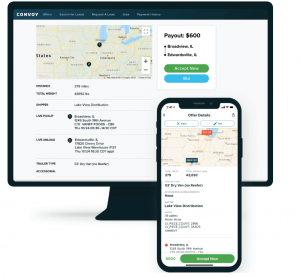
Convoy is another digital freight network, available for mobile and web platforms. The Convoy logistics app was founded in 2015 in Seattle. Now the platform has 500 employees, has earned $265 million, and reached a value of more than $1 billion. Convoy’s main investors are CapitalG, Amazon founder Jeff Bezos and venture capital firm Greylock Partners.
Like Uber Freight, Convoy matches shippers and companies with trucks using drivers’ locations.
- To start receiving requests, drivers need to register in the app and give details about their truck. Carriers also add the pickup and drop off locations on their routes and available updates.
- Then, the driver sees a shippers’ requests in the Bids section. It includes detailed information about the cargo, the money they will receive for the delivery, and haul length.
- Once the driver has delivered the order, Convoy suggested other shipments nearby in the Reloads section.
To reduce the amount of paperwork, Convoy has a digital Shipping documents section. Here, shippers can upload all cargo-deleted documents via the web or mobile application.
Doft
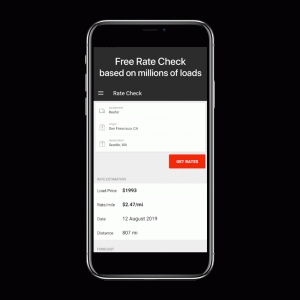
Doft is a small yet prospective on-demand truck sharing platform. It allows freight shippers to book trucks from independent commercial truck drivers via mobile app.
App for shippers includes the following functionality:
- Book regular or prepaid on-demand loads
- Estimate freight rates
- Ask and answer questions via a built-in chat
- See active shipment in real-time and get notifications on the delivery status
The app also allows shippers to track their cargo in real-time and rate the driver after the delivery.
For drivers, the app offers a bunch of handy features, such as
- AI-powered Freight market rate forecast
- Rate check – free freight rate calculator & average market rate forecast
- Fuel surcharge calculator
- Calling brokers and shippers right from the app
- Upfront pricing for prepaid loads
- Loads search based on driver’s favorite lanes, city, state, zip code or GPS data
Now, let’s look at your app for truck delivery, its essential features, and development costs.
Essential features for an on-demand trucking app
As we said earlier, Uber for commercial trucking consists of three main parts. They are the driver app, the shipper’s app, and the web-based admin dashboard.
As mobile app developers, we recommend starting your app small. This means you need to focus on the most critical functions that will be the core of your app’s first version (MVP). You can then add other features later. We apply this proven project development approach for all sophisticated projects.
Below, we list essential features for each part of your project and give a list of “nice to have” functions you can add after the project launch.
Driver app for finding loads
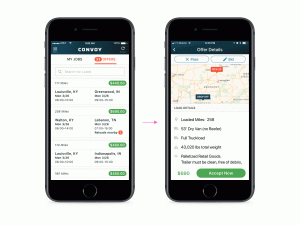
The main goal of a driver’s truck logistics app is to show new shipping orders and their information (size, weight, description), and allow them to accept or decline orders.
The app also must include a map with the pickup, drop off location, and allow the driver to receive payments for each order delivered. Thus, essential functionality for a driver’s application is the following:
- Driver registration
- Vehicle information
- Current orders list
- Accept or decline orders functionality
- Order search section with filtering option
- Order details with shipper contact information
- Build-in payment gateway to receive payments
- GPS-based map with routes, fuel stations, and motels
- Digital documentation section to upload the bill of lading
- Real-time notifications for upcoming job and payment
Shipper app for posting freight

An app for the shipper could be web or mobile-based. As a shipper, you need to place a shipping order and provide information about it. Then, select the carrier with the best rates, track your delivery, and pay for it. It would also be great to receive notifications at the end of delivery. Thus, the shipper app should include:
-
- Shipper registration
- Order placing section with cargo weight, size, destination, pickup and drop-off location, date of delivery, etc.
- Online documentation section to upload delivery-related documents
- List of offers from carriers with estimated delivery time, rates, rating, contact details
- Payment gateway to pay for the delivery
- Real-time order tracking on the map
- Delivery confirmation via uploaded photos
Admin panel for managing platform
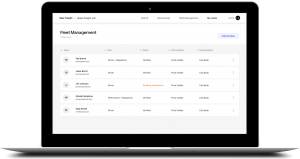
The admin panel is a web-based app to manage the interaction between shippers and carriers. Here, managers will supervise current and finished deliveries, payment transactions, and delivery rates. Admins can also gather and maintain information about users. For these tasks, the admin panel should consist of:
- Two-factor authentication to prevent data breaches and unauthorized access
- Dashboard with the list of upcoming orders, current orders located on the map, as well as completed deliveries
- Carrier queries with a list of new drivers who want to register on your platform
- Matching algorithm to match shippers and carriers based on location, freight details, etc
- Billing and invoicing service to approve invoices and billing generated by drivers and shippers.
- Trip Log Reports to record the duration of every trip booked via your platform. It should include start and end dates and time, miles covered, and orders fulfilled.
Advanced functions for Uber for trucking applications
Apart from the essential features listed above, you can also integrate some advanced functionality to stand out from your competitors. We suggest such functionality, as
- Built-in messaging to connect shippers and drivers in real-time
- Real-time traffic analytics and route optimization algorithm to suggest the driver the best route
- Weather updates to show more realistic delivery time
- Fuel prices map to offer driver stations with the lowest fuel costs
- Built-in calendar to allow shippers to schedule the delivery beforehand
- Suggested shippings to offer carriers new orders on the basis of their current location
How much on-demand logistics app development costs
Several factors impact the cost of a shipping app like Uber. Here are some of them:
- Number of features
The more features you want to install, the higher the cost you will pay to your development team. That is why we suggest implementing essential functions first. In this way, you can prove your business idea and check whether such an app would be demanding among your audience.
Besides this, some features vary in cost of implementation. For instance, functionality, like calendars, payment gateways, and maps can be implemented via API, which costs from about $2,000. On the other hand, sophisticated custom A.I. algorithms need a considerable amount of work and may cost from $10,000 per feature.
- Number of platforms
Since the platform includes driver and shipper mobile apps, you need to decide whether to build these apps for iOS or Android. You can also develop apps for both platforms, which will double your expenses.
To make an informed decision, read our previous article iOS VS Android, where we talk about the advantages and disadvantages of both platforms. In a nutshell, your choice will depend on your audience, the region you launch your transport delivery app, and the essential features of your app.
To dig deeper into other price-forming factors, check out our article on how to estimate mobile project costs.
- Location of your development team
While developers from Eastern Europe and the U.S. have similar skill sets, the prices on their services differ. For example, Ukrainian mobile developers charge $30-45 per hour, while developers from the United States will cost you from $90 per hour.
To receive handy tips on how to select the best development team, read our previous post.
If you want to receive an answer on how much Uber for trucking costs, feel free to use our project cost calculator.
Conclusion
Examples of Uber for trucking, Convoy, and Doft, show that the on-demand trucking platform is an excellent way of investing for a startup. Besides this, such a platform can reduce the number of empty miles for an existing logistics business. Thus, you can make your own pickup truck app like Uber and earn money on every mile driven.
To develop a logistics delivery app, you can use the feature list described in this article, or create your feature list to meet your business needs.